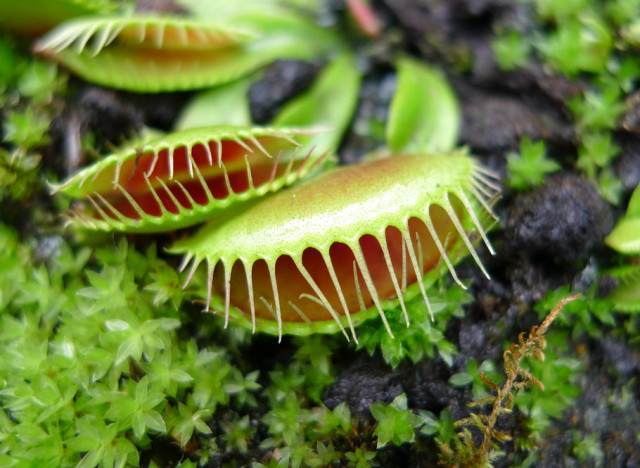The name Venus Flytrap is a dichotomy. Venus is the goddess of love but the 'flytrap' part of the name indicates otherwise. We bet you're wondering how can it be that a plant can eat prey? It sounds like a science experiment gone awry.
The Venus flytrap, botanically named Dionaea muscipula, really does catch and digest animal prey -- primarily insects and spiders. The trap part of the plant that moves to envelop its prey is actually triggered by tiny little hairs on the inside of the trap. When a victim crawls into the trap, it unknowingly comes in to contact with one of those hairs. The plant will wait until a second hair is triggered to swallow up its prey.

Flickr photo by cuttlefish
By not immediately closing with the insects first brush, the Venus saves its energy by trapping only what it will actually use. They know the difference between an actual insect and someone sticking their finger in it to see if it will close.
Once triggered, the trap will close quickly and if the insect even thought it had a chance to survive it will not get past the the lobes edges which are also covered with teeth that bond together to make a tough seal. The only way an insect would escape is if it's too tiny by crawling out one of the small holes in the trap. The tiny, tiny guys are not worth the plant's time of digestion, instead, the Venus flytrap has bigger plans. If the prey is too small and manages to get out, the trap will reopen once again (but not immediately) to silently hunt. If the insect tries to fight, the trap will tighten even more and start to digest at a more rapid rate.
The Venus Flytrap is a bog plant normally found in nitrogen and phosphorus poor soils. When this carnivorous plant can't get the nutrition it needs from the soil, it takes it instead from the captured insects for protein formation. Pot them in a soil that has very low nutrient levels and don't worry about fertilizing them. You can make your own potting mix by blending peat, sphagnum moss, sand and perlite. Because they are bog plants they do like to be kept evenly moist. Make sure to use a pure water like distilled or rain water. The more sun you give them the healthier they will be.
The Venus flytrap is native to North and South Carolina thus it is not a tropical plant and does not like to be kept in warm growing conditions all of the time. It will need to go through cooler dormancy periods in order to survive. If you do not give your plant a dormancy period once in a while it will deteriorate and eventually die. They normally grow and bloom like a perennial plant during the spring and summer then in the winter they are allowed to die back and 'sleep' only to grow again in the spring. If you decide to have one of these beasts as a houseplant you will need to try and recreate its normal growing conditions and habitat.
Venus Flytraps will produce flowers but you might want to remove them as soon as you start to see them, as it will take energy away from the plant when it could be focusing on producing more traps. The speed at which the trap closes can vary according to growing conditions and can be used as an indicator as to how happy and healthy your Venus flytrap. So pay attention to them - not like that is hard to do. Hello Venus Flytrap, you lethally beautiful thing.